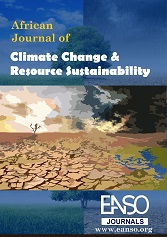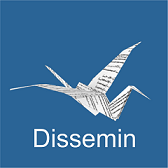Assessment of the Effect of Drought on Cattle Keeping Households in Migori County
Abstract
Cattle keeping plays a crucial role in ensuring food security and fulfilling socio-cultural functions in both developed and developing regions. However, most cattle in these regions are often raised under extensive production systems, making them highly vulnerable to harsh environmental conditions. Among the most pressing challenges facing cattle production in sub-tropical regions is drought, which leads to severe water scarcity and depletion of grazing resources, resulting in reduced cattle productivity, increased susceptibility to diseases, and, in extreme cases, high mortality rates. This study assessed the effects of drought on cattle-keeping households in Migori County. In semi-arid areas of Migori County, cattle keeping plays vital economic and socio-cultural roles but is increasingly affected by drought-related challenges such as water scarcity, pasture depletion, and livestock diseases. The study was conducted in Nyatike and Kuria West sub-counties of Migori County, selected for their diverse agro-ecological zones affecting livestock farming. Data were collected through structured household questionnaires, key informant interviews, and direct observation, with a stratified sample of 383 households proportionately drawn from four wards. The abstract claims Masaba was affected by diseases, but Table 2 shows Masaba had only 19% disease reports compared to Muhuru’s 54%. Cattle mortality stood at 37%, and nearly 90% of households reported some degree of cattle emaciation, indicating widespread nutritional stress. Masaba and Kanyarwanda Wards experienced the most severe declines in production and cattle prices, while Muhuru, despite high disease and emaciation rates, reported more stable cattle prices, suggesting stronger market structures or fewer distress sales. This study highlights the significant impact of drought on cattle health, production, and market dynamics across Migori County. To mitigate these impacts, the study recommends strengthening veterinary services, enhancing market resilience, and integrating drought preparedness into livestock management and policy frameworks to protect livelihoods and improve resilience in the livestock sector.
Downloads
References
ACTED. (2011). Drought emergency response in Northern Kenya. Agency for Technical Cooperation and Development (ACTED).
Baluka, S. A., Gwakisa, P. S., Kateregga, J., & Musisi, N. L. (2014). Socio-economic impact of livestock diseases and their control in Uganda. International Journal of Animal and Veterinary Advances, 6(2), 55–63. https://doi.org/10.19026/ijava.6.5741
Baluka, S. A., Gwakisa, P. S., Kateregga, J., & Musisi, N. L. (2014). Socio-economic impact of livestock diseases and their control in Uganda. International Journal of Animal and Veterinary Advances, 6(2), 55–63. https://doi.org/10.19026/ijava.6.5741
Baylis, M., & Githeko, A. K. (2006). The effects of climate change on infectious diseases of animals. Foresight Project on Detection of Infectious Diseases, 8, 1–35. Government Office for Science, UK.
Baylis, M., & Githeko, A. K. (2006). The effects of climate change on infectious diseases of animals. Foresight Project on Detection of Infectious Diseases, 8, 1–35. Government Office for Science, UK.
Below, T. B., Mutabazi, K. D., Kirschke, D., Franke, C., Sieber, S., Siebert, R., & Tscherning, K. (2010). Can farmers’ adaptation to climate change be explained by socio-economic household-level variables? Global Environmental Change, 20(1), 223–235. https://doi.org/10.1016/j.gloenvcha.2009.10.003
Bhavnani, R., Vordzorgbe, S., Owor, M., & Bousquet, F. (2008). Report on the status of disaster risk reduction in the Sub-Saharan Africa region. United Nations International Strategy for Disaster Reduction (UNISDR).
Biradar, N. (2017). Impact of drought on livestock and adaptation strategies in Rajasthan. Indian Journal of Animal Sciences, 87(9), 1120–1125.
Choudhary, R. S. (2017). Drought and its impact on indigenous cattle populations in India: A case study from Rajasthan. International Journal of Livestock Research, 7(12), 35–41. https://doi.org/10.5455/ijlr.20171205021455
FAO. (2005). Impact of drought on sub-Saharan African livestock. Food and Agriculture Organization of the United Nations.
FAO. (2008). Climate-related transboundary pests and diseases. FAO Animal Production and Health Division. https://www.fao.org
FAO. (2024). Zimbabwe drought update: El Niño-induced livestock losses in 2023/2024 farming season. Food and Agriculture Organization of the United Nations. https://www.fao.org
Cecchi, G., Mattioli, R. C., Slingenbergh, J., & De La Rocque, S. (2014). Land cover and tsetse fly distributions in sub-Saharan Africa. Medical and Veterinary Entomology, 29(2), 164–173. https://doi.org/10.1111/mve.12076
Gebremedhin, B., & Swinton, S. M. (2003). Investment in soil conservation in northern Ethiopia: The role of land tenure security and public programs. Agricultural Economics, 29(1), 69–84. https://doi.org/10.1111/j.1574-0862.2003.tb00148.x
(Note: Although focused on land tenure, this paper includes cattle pricing under environmental stress.)
Gebremedhin, B., & Swinton, S. M. (2003). Investment in soil conservation in northern Ethiopia: The role of land tenure security and public programs. Agricultural Economics, 29(1), 69–84. https://doi.org/10.1111/j.1574-0862.2003.tb00148.x (Note: Although focused on land tenure, this paper includes cattle pricing under environmental stress.)
GoK (Government of Kenya). (2011). Post-drought assessment report: Kajiado and Narok counties. Ministry of Agriculture, Livestock, and Fisheries.
Grisi, L., Leite, R. C., Martins, J. R. S., Barros, A. T. M., Andreotti, R., Cançado, P. H. D., ... & Villela, H. S. (2002). Impacto econômico das principais ectoparasitoses em bovinos no Brasil. Revista Brasileira de Parasitologia Veterinária, 11(3), 81–87. (In Portuguese; English translation: "Economic impact of the main ectoparasitoses in cattle in Brazil.")
Hellmuth, M. E., Moorhead, A., Thomson, M. C., & Williams, J. (Eds.). (2007). Climate risk management in Africa: Learning from practice. International Research Institute for Climate and Society (IRI), Columbia University.
Henderson, J., & Kauffman, N. (2012). Drought's impact on the cattle sector: Scattered, but severe. Federal Reserve Bank of Kansas City: Main Street Economist. https://www.kansascityfed.org
Henderson, J., & Kauffman, N. (2012). Drought's impact on the cattle sector: Scattered, but severe. Federal Reserve Bank of Kansas City: Main Street Economist. https://www.kansascityfed.org
Houghton, J. T. (2001). Climate change 2001: The scientific basis. Intergovernmental Panel on Climate Change (IPCC). Cambridge University Press.
Kebede, T., Zinabu, T., Ferede, S., & Dugassa, S. (2018). Climate change and livestock production in Ethiopia: Impacts and adaptation strategies. Journal of Natural Sciences Research, 8(7), 1–9.
Kebede, T., Zinabu, T., Ferede, S., & Dugassa, S. (2018). Climate change and livestock production in Ethiopia: Impacts and adaptation strategies. Journal of Natural Sciences Research, 8(7), 1–9.
Kipkemboi, J., & Ndungu, J. (2021). Drought preparedness and its effect on livestock market resilience in southern Kenya. African Journal of Environmental Science and Technology, 15(8), 305–314. https://doi.org/10.5897/AJEST2021.3014
Kipkemboi, J., & Ndungu, J. (2021). Drought preparedness and its effect on livestock market resilience in southern Kenya. African Journal of Environmental Science and Technology, 15(8), 305–314. https://doi.org/10.5897/AJEST2021.3014
Krejcie, R.V. & Morgan, D.W. (1970). Determining Sample Size for Research Activities. Educational and Psychological Measurement, 30:607-610.
Lubungu, M., Burke, W. J., & Sitko, N. J. (2012). Analysis of the determinants of market participation within Zambia’s cattle market system (Working Paper No. 66). Indaba Agricultural Policy Research Institute (IAPRI). https://www.agrilinks.org/sites/default/files/resource/files/IAPRI_WP_66.pdf
Maass, B. L., Musale, D. K., Chiuri, W. L., Gassner, A., & Peters, M. (2012). Challenges and opportunities for smallholder livestock production in post-conflict South Kivu, eastern DR Congo. Tropical Animal Health and Production, 44, 1221–1232. https://doi.org/10.1007/s11250-011-0041-5
McCarthy, J. J., Canziani, O. F., Leary, N. A., Dokken, D. J., & White, K. S. (Eds.). (2001). Climate change 2001: Impacts, adaptation and vulnerability. Contribution of Working Group II to the Third Assessment Report of the Intergovernmental Panel on Climate Change. Cambridge University Press.
Menike, L. M. C. S., & Arachchi, K. G. B. (2016). Adaptation to climate change by smallholder farmers in rural communities: Evidence from Sri Lanka. Procedia Food Science, 6, 288–292. https://doi.org/10.1016/j.profoo.2016.02.057
Michaleowa, A., & Sirohi, S. (2007). Leakage and additionality in agricultural CDM. Energy Policy, 35(8), 4321–4334. https://doi.org/10.1016/j.enpol.2007.02.017
Morton, J. F. (2005). The impact of climate change on smallholder and subsistence agriculture. Proceedings of the National Academy of Sciences, 104(50), 19680–19685. https://doi.org/10.1073/pnas.0701855104
Musowe, N., & Mmatlou, K. (2021). The impact of livestock diseases on cattle marketing and farmer livelihoods in rural South Africa. African Journal of Agricultural Economics and Rural Development, 9(2), 44–53.
Mutibvu, T., Maburutse, B. E., Mbiriri, D. T., & Kashangura, M. T. (2012). Constraints and opportunities for increased livestock production in communal areas: A case study of Simbe, Zimbabwe. Livestock Research for Rural Development, 24(9). http://www.lrrd.org/lrrd24/9/muti24164.htm
Mutibvu, T., Maburutse, B. E., Mbiriri, D. T., & Kashangura, M. T. (2012). Constraints and opportunities for increased livestock production in communal areas: A case study of Simbe, Zimbabwe. Livestock Research for Rural Development, 24(9). http://www.lrrd.org/lrrd24/9/muti24164.htm
Mwiturubani, D. A., & van Wyk, J.-A. (2010). Climate change and natural resources conflicts in Africa. Institute for Security Studies (ISS).
Msangi, J.P. (2004). Drought hazard and desertification management in the drylands of southern Africa. Environ. Monit. Assess. 2004, 99, 75–87.
National Drought Management Authority (NDMA). (2023). Drought situation report – Kenya: March 2023. Government of Kenya. https://www.ndma.go.ke
Ng’ang’a, S. K., Opiyo, F. E. O., & Wasonga, O. V. (2020). Impacts of climate stress on cattle marketing in pastoral regions of northern Kenya. Pastoralism, 10, Article 9. https://doi.org/10.1186/s13570-020-00163-7
Ng’ang’a, S. K., Opiyo, F. E. O., & Wasonga, O. V. (2020). Impacts of climate stress on cattle marketing in pastoral regions of northern Kenya. Pastoralism, 10, Article 9. https://doi.org/10.1186/s13570-020-00163-7
Ngaira, J. K. W. (2007). Impact of climate change on agriculture in Africa by 2030. Scientific Research and Essays, 2(7), 238–243.
Nicholson, C. F. (2014). Livestock, drought, and disaster response in sub-Saharan Africa: A review. East African Agricultural and Forestry Journal, 80(1), 30– 39. https://doi.org/10.1080/00128325.2014.974306
Ntali, Y.M.; Lyimo, J.G.; Dakyaga, F. (2023). Trends, impacts, and local responses to drought stress in Diamare Division, Northern Cameroon. World Dev. Sustain. 2023, 2, 100040.
Ochieng’, W. O. (2018). Effects of drought on livestock productivity in Baringo County, Kenya. International Journal of Agricultural Policy and Research, 6(3), 47–53.
Ogutu, J. O., Piepho, H. P., Said, M. Y., Ojwang, G. O., Njino, L. W., Kifugo, S. C., & Wargute, P. W. (2016). Extreme wildlife declines and concurrent increase in livestock numbers in Kenya: What are the causes? PLOS ONE, 11(9), e0163249. https://doi.org/10.1371/journal.pone.0163249
Ogutu, J. O., Piepho, H. P., Said, M. Y., Ojwang, G. O., Njino, L. W., Kifugo, S. C., & Wargute, P. W. (2016). Extreme wildlife declines and concurrent increase in livestock numbers in Kenya: What are the causes? PLOS ONE, 11(9), e0163249. https://doi.org/10.1371/journal.pone.0163249
Opiyo, F. E. O., Wasonga, O. V., & Nyangito, M. M. (2014). Effects of drought on pastoral and agro-pastoral households in Kenya: The case of Laikipia County. Journal of Social Development in Africa, 29(1), 165–192.
Orinda, V. A., Murray, L., & Wamicha, W. (2007). Coping strategies used by livestock farmers in Kenya’s arid and semi-arid lands. Pastoralism, 1(1), 22–31.
Ouma, E., Abdulai, A., & Drucker, A. G. (2014). Measuring heterogeneous preferences for cattle traits among Ugandan cattle-keeping households. Agricultural Economics, 45(4), 411–421. https://doi.org/10.1111/agec.12074
Rust, J. M. (2013). The impact of climate change on extensive and intensive livestock production systems. Animal Frontiers, 3(1), 62–65. https://doi.org/10.2527/af.2013-0009
Scheffran, J., Marmer, E., & Sow, P. (2012). Migration as a contribution to resilience and innovation in climate adaptation: Social networks and co-development in Northwest Africa. Applied Geography, 33, 119–127. https://doi.org/10.1016/j.apgeog.2011.10.002
Scott, D., & Kreitman, K. (2023). Cattle prices and drought: Economic impacts on ranchers in the U.S. U.S. Department of Agriculture Economic Research Service (USDA ERS). https://www.ers.usda.gov
Scott, D., & Kreitman, K. (2023). Cattle prices and drought: Economic impacts on ranchers in the U.S. U.S. Department of Agriculture Economic Research Service (USDA ERS). https://www.ers.usda.gov
State Bank of Pakistan. (2004). Annual report 2003–2004: The state of the Pakistan economy. Government of Pakistan.
Stroebel, A., Swanepoel, F. J. C., Nthakheni, N. D., Nesamvuni, A. E., & Taylor, G. (2008). Benefits obtained from cattle by smallholder farmers: A case study of Limpopo Province, South Africa. Australian Journal of Experimental Agriculture, 48(7), 825–828. https://doi.org/10.1071/EA07162
Stroebel, A., Swanepoel, F. J. C., Nthakheni, N. D., Nesamvuni, A. E., & Taylor, G. (2008). Benefits obtained from cattle by smallholder farmers: A case study of Limpopo Province, South Africa. Australian Journal of Experimental Agriculture, 48(7), 825–828. https://doi.org/10.1071/EA07162
Thornton, P. K., van de Steeg, J., Notenbaert, A., & Herrero, M. (2009). The impacts of climate change on livestock and livestock systems in developing countries: A review of what we know and what we need to know. Agricultural Systems, 101(3), 113–127. https://doi.org/10.1016/j.agsy.2009.05.002
Thornton, P. K., van de Steeg, J., Notenbaert, A., & Herrero, M. (2009). The impacts of climate change on livestock and livestock systems in developing countries: A review of what we know and what we need to know. Agricultural Systems, 101(3), 113– 127. https://doi.org/10.1016/j.agsy.2009.05.002
Wahab, M. (2002). Drought and the livestock sector: A case study of Pakistan. Pakistan Journal of Agricultural Economics, 5(2), 91–98.
Magita, J. G., & Sangeda, A. Z. (2017). Impacts of climate change on livestock health: A case study of pastoral communities in Tanzania. Livestock Research for Rural Development, 29(3). http://www.lrrd.org/lrrd29/3/magi29055.html
Ndungu, J. M., Nyamwaro, S. O., & Ouma, E. A. (2020). Effects of climate variability on livestock diseases in Laikipia County, Kenya. African Journal of Agricultural Research, 15(9), 1349–1358. https://doi.org/10.5897/AJAR2020.14924
Ogutu, J. O., Piepho, H. P., Said, M. Y., Kifugo, S. C., & Wargute, P. W. (2019). Herbivore dynamics and range contraction in Kenya’s rangelands. Biological Conservation, 236, 136– 147. https://doi.org/10.1016/j.biocon.2019.05.037
Copyright (c) 2025 Pauline Wegesa Nyamohanga, Kennedy Nyabuti Ondimu, PhD, Amon Mwangi Karanja, PhD

This work is licensed under a Creative Commons Attribution 4.0 International License.




























